Hooking your kids on junk food is a billion dollar business. According to a recent study by the Federal Trade Commission, the food and beverage industry spends nearly $2 billion a year on targeted marketing to children and teens. That’s some serious dough—and it’s not just going toward Sponge Bob TV ads. In fact, the many ways the food industry targets kids might surprise you. Here are some of my favorite ridiculous examples.
Table of Contents
1. Shrek Hawking Twinkie’s
[fusion_builder_container hundred_percent=”yes” overflow=”visible”][fusion_builder_row][fusion_builder_column type=”1_1″ background_position=”left top” background_color=”” border_size=”” border_color=”” border_style=”solid” spacing=”yes” background_image=”” background_repeat=”no-repeat” padding=”” margin_top=”0px” margin_bottom=”0px” class=”” id=”” animation_type=”” animation_speed=”0.3″ animation_direction=”left” hide_on_mobile=”no” center_content=”no” min_height=”none”]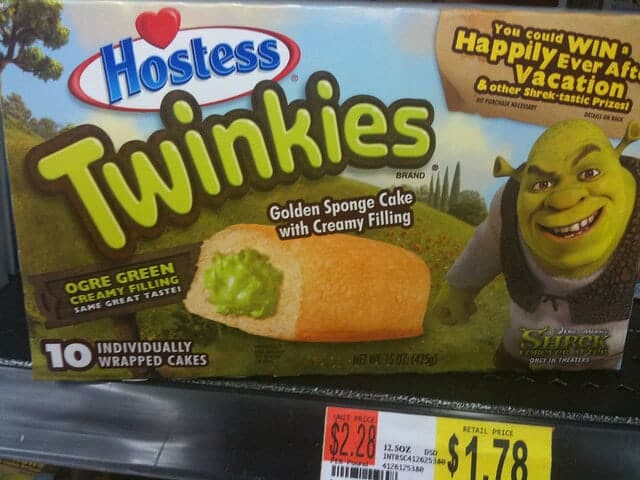
Yum. Ogre Green Creamy Filling sounds awesome, doesn’t it? Using lovable kids’ characters to sell junk food to kids is a time-honored trick. Too bad this Twinkie will deliver a whopping 37 grams of sugar, or about 7 teaspoons—and a Shrek-sized meltdown.
2. Twizzler’s Percentage Book
What’s wrong with this picture? 100% of the book is about selling kids on candy. (Math books hawking candy aren’t just limited to fractions: There’s a Twizzlers Shapes and Patterns schoolbook by the same authors, too. Sure, I like a box of Twizzlers as much as anyone, but should we really be using candy to teach our kids math? Under the cover of “education,” candy giants like Twizzlers, M&M’S and Reese’s partner up with reputable publishers like Scholastic. Together, they insinuate themselves into classrooms, undermining the important work of teachers trying to educate kids about healthy diets that aren’t chock-full of sugar, artificial flavors… and Twizzlers.
3. Would you like a Happy Meal with that Report Card?
[/fusion_builder_column][fusion_builder_column type=”1_1″ background_position=”left top” background_color=”” border_size=”” border_color=”” border_style=”solid” spacing=”yes” background_image=”” background_repeat=”no-repeat” padding=”” margin_top=”0px” margin_bottom=”0px” class=”” id=”” animation_type=”” animation_speed=”0.3″ animation_direction=”left” hide_on_mobile=”no” center_content=”no” min_height=”none”]
In 2008, McDonald’s sparked outrage from parents when the company agreed to cover the printing costs of report-card jackets for all 27,000 children in a Florida’s Seminole County school district. The envelopes promised a free Happy Meal to students “who earned all A’s or B’s, two or fewer absences, or good behavior in a given academic quarter,” according to AdAge. Concerned about McDonald’s co-branding with a public school district and promising a junk food reward directly to children, area parents contacted the Campaign for a Commercial-Free Childhood, which kicked into gear. More than 2,000 calls of protest later, the school district dropped the partnership.
4. The My Coke Rewards Sham
[/fusion_builder_column][fusion_builder_column type=”1_1″ background_position=”left top” background_color=”” border_size=”” border_color=”” border_style=”solid” spacing=”yes” background_image=”” background_repeat=”no-repeat” padding=”” margin_top=”0px” margin_bottom=”0px” class=”” id=”” animation_type=”” animation_speed=”0.3″ animation_direction=”left” hide_on_mobile=”no” center_content=”no” min_height=”none”]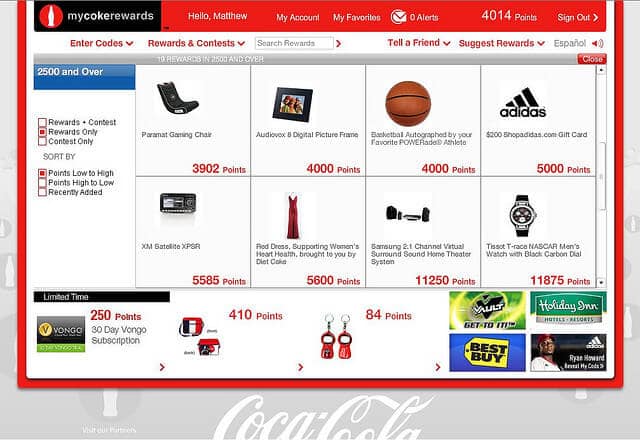
Launched in early 2006, My Coke Rewards is marketing thinly veiled as charity: The concept is that for every Coke product you purchase you earn points toward “prizes,” including school rewards like an inflatable bowling set or colored pencils. The corporation pushes My Coke Rewards as a great way to raise resources for schools. Many Parent Teacher Associations seem to agree, pushing the program to students and parents through official newsletters and emails to the community. But in reality, the program is a not-so-subtle way to market sugary drinks and branded products to young people while the company benefits from the illusion of being part of the school community. We did the math and to earn your school just one “Physical Best Activity Pack” from Coke (including a few jump ropes, whistles, cones, and more) you’d need to buy 55,440 cans of soda. Stacked end-to-end, they’d stretch farther than 73 football fields.
5. Ronald in Schools
[/fusion_builder_column][fusion_builder_column type=”1_1″ background_position=”left top” background_color=”” border_size=”” border_color=”” border_style=”solid” spacing=”yes” background_image=”” background_repeat=”no-repeat” padding=”” margin_top=”0px” margin_bottom=”0px” class=”” id=”” animation_type=”” animation_speed=”0.3″ animation_direction=”left” hide_on_mobile=”no” center_content=”no” min_height=”none”]
Imagine your kid walks into a school assembly, one that all kids are required to attend, only to be greeted by someone dressed up as the Marlboro Man. He’s there to teach your kids about community and leadership. You’d probably be shocked, right? Now, imagine a costume change: Instead of Marlboro Man it’s Ronald McDonald. Today, the consumption of foods and drinks high in fat, salt, or sugar sold by the Golden Arches are one of the leading causes of diet-related illnesses. Yet, Ronald is regularly touring elementary schools across the country. The “Giving Back with Ronald McDonald®” 40-minute “educational” program is free for schools and uses “music, magic, skits, and games to inspire elementary school kids to give back to the community and others”—starring Ronald, of course.
6. A Sound Only Kids Can Hear? Social Media and New Technology
[/fusion_builder_column][fusion_builder_column type=”1_1″ background_position=”left top” background_color=”” border_size=”” border_color=”” border_style=”solid” spacing=”yes” background_image=”” background_repeat=”no-repeat” padding=”” margin_top=”0px” margin_bottom=”0px” class=”” id=”” animation_type=”” animation_speed=”0.3″ animation_direction=”left” hide_on_mobile=”no” center_content=”no” min_height=”none”]In 2007, KFC tried out a new online video ad campaign for its supposedly family-friendly Boneless Variety Bucket meal. The ads contained a high-pitched noise that allegedly only kids could hear. (Though I’m no kid, I could hear it just fine). The first 1,000 kids to correctly identify when the sound occurred in the video were promised a $10 gift certificate to KFC. While the food industry touts the success of its voluntary moves to reduce marketing to kids and teens, many food companies are actually expanding targeted marketing, trying out new forms of online and social media marketing, like this video campaign. Studies are finding an increase in companies using online campaigns, social media, text messages and more to get to kids, even using children as “brand ambassadors” to sell their friends on junk food.
7. HappyMeal.com
[/fusion_builder_column][fusion_builder_column type=”1_1″ background_position=”left top” background_color=”” border_size=”” border_color=”” border_style=”solid” spacing=”yes” background_image=”” background_repeat=”no-repeat” padding=”” margin_top=”0px” margin_bottom=”0px” class=”” id=”” animation_type=”” animation_speed=”0.3″ animation_direction=”left” hide_on_mobile=”no” center_content=”no” min_height=”none”]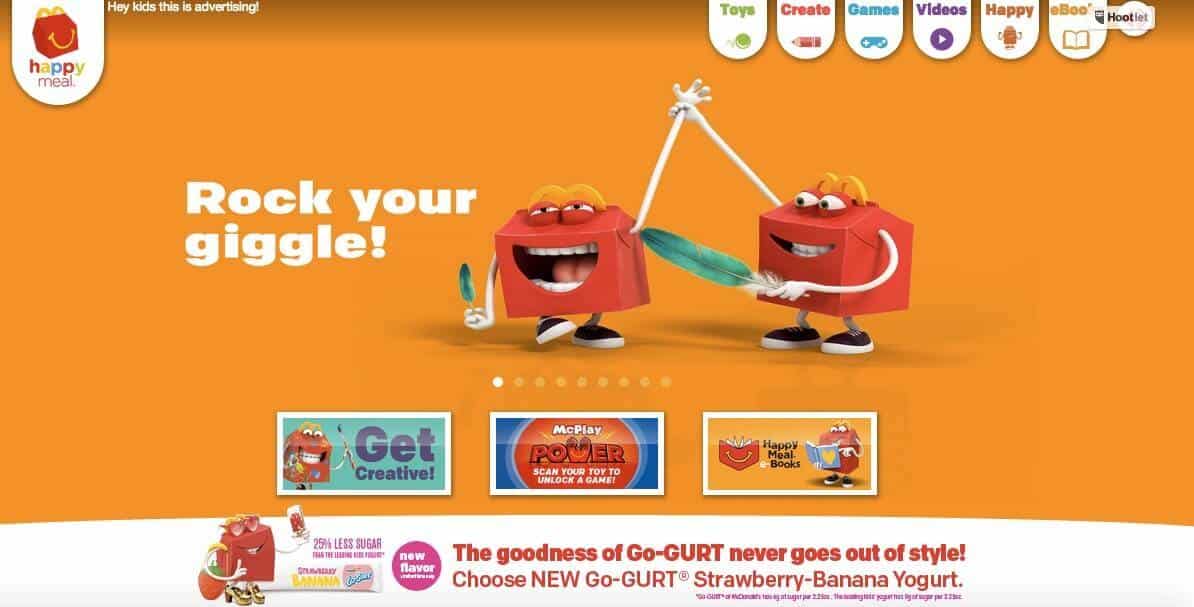
HappyMeal.com is McDonald’s premier online platform to reach kids: a colorful website with fun activities that cleverly disguises its advertising intent to push its salt, sugar, and fat-loaded junk food on kids. (Note the tiny font in top right corner that says: “Hey kids, this is advertising!” Like any kid would notice it). The site works to develop brand loyalty among young kids and to associate the brand with fun. Every single pixel of HappyMeal.com is designed to enrapture children—and hook them on fast food. By using the websites like HappyMeal.com, companies like McDonald’s are ever more able to bypass the “gatekeeper” (aka parents) who may be putting restrictions on TV-watching precisely to protect their kids from such marketing. All these new ways to reach kids are adding up: Traditional “measured media” (e.g. television, radio, and print) only made up 39% of all marketing spending reported to the FTC, totaling just $695 million in 2009, down significantly from the $848 million spent in 2006 as companies focus on new media platforms like HappyMeal.com.
8. Honey Nut Cheerios and the Sugar-for-Breakfast Phenomenon
[/fusion_builder_column][fusion_builder_column type=”1_1″ background_position=”left top” background_color=”” border_size=”” border_color=”” border_style=”solid” spacing=”yes” background_image=”” background_repeat=”no-repeat” padding=”” margin_top=”0px” margin_bottom=”0px” class=”” id=”” animation_type=”” animation_speed=”0.3″ animation_direction=”left” hide_on_mobile=”no” center_content=”no” min_height=”none”]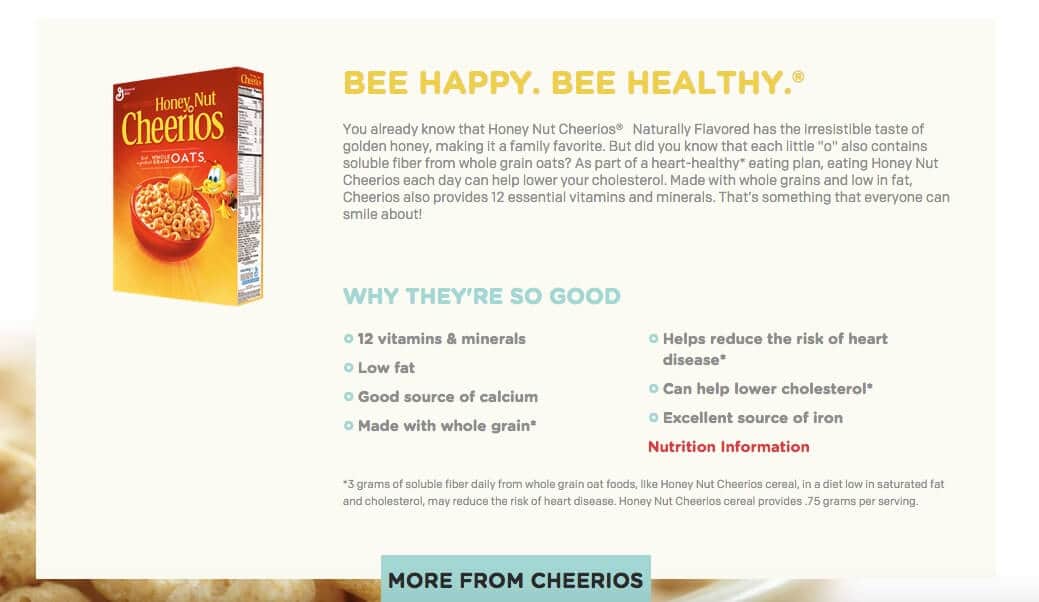
Now, this box of Honey Nut Cheerios may not, on its surface, seem the most ridiculous child-centered marketing you’ve ever seen, but not so fast. Sugary cereal is one of the biggest profit-makers for multinational corporations like General Mills. These brands are big spenders when it comes to targeting kids. In fact, Yale’s Rudd Center found that total media spending to promote child-targeted cereals has increased by 34 percent from 2008 to 2011. And General Mills spent more on marketing Honey Nut Cheerios in 2011 than any other cereal company: $73 million, to be exact. The box brags that the cereal “can help lower cholesterol” and that its first ingredient is a whole grain. It certainly doesn’t brag that its second, fifth, and sixth ingredients are sugars, or that a kid eating just one 3/4 cup serving would get 9 grams of sugar, or a little more than 2 teaspoons.
9. Puff, Puff
[/fusion_builder_column][fusion_builder_column type=”1_1″ background_position=”left top” background_color=”” border_size=”” border_color=”” border_style=”solid” spacing=”yes” background_image=”” background_repeat=”no-repeat” padding=”” margin_top=”0px” margin_bottom=”0px” class=”” id=”” animation_type=”” animation_speed=”0.3″ animation_direction=”left” hide_on_mobile=”no” center_content=”no” min_height=”none”]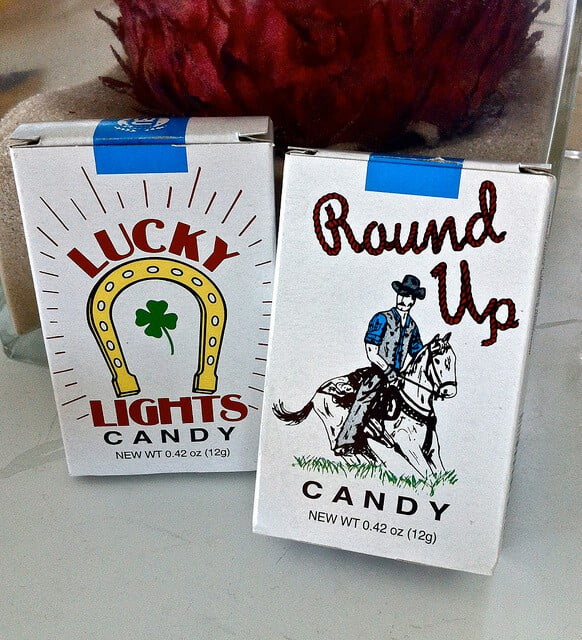
Saving the best for last: It was not too long ago that you could get these candy cigarettes—yes, you heard me right: candy cigarettes—at any corner store. I still remember the taste of the powdery sugar flavor on my tongue when I was a kid. Unbelievably, we only recently issued a federal ban on this candy when the FDA’s Family Smoking Prevention and Control Act passed in 2009. As it turns out, the junk food marketers have swiped a page or two from the tobacco industry playbooks and use many of the same tactics and the same PR and lobbying reps, too.
You can learn more about how marketing to children undermines parents in my new movie and test your smarts on the topic with our online quiz. You can also sign our petition calling on McDonald’s to stand up for kids’ health and take down HappyMeal.com.

About the Author:
Anna Lappé is a national bestselling author and widely respected educator, known for her work as an expert on food systems and as a sustainable food advocate. The co-author or author of three books and the contributing author to ten others, Anna’s work has been translated internationally and featured in The New York Times, Gourmet, Oprah Magazine, among many other outlets. Named one of TIME magazine’s “eco” Who’s-Who, Anna is a founding principal of the Small Planet Institute and the Small Planet Fund with her mother, Frances Moore Lappé. She is also the founder and director of the Real Food Media Project, which uses creative movies, an online movie contest, a web-based action center, and grassroots events to grow the movement for sustainable food and farming.[/fusion_builder_column][/fusion_builder_row][/fusion_builder_container]

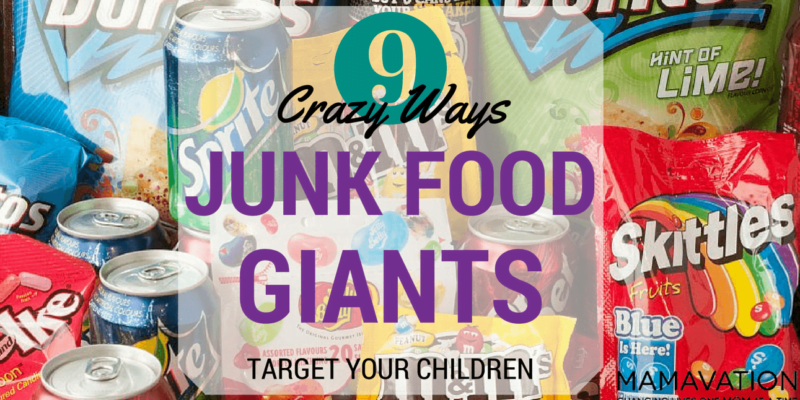

 Iced Tea Culprits: These Brands Can Sour Your Summer
Iced Tea Culprits: These Brands Can Sour Your Summer
Great post! It would be interesting to see whole foods companies using the same tactics to successfully spread a message of health for our kids! Parenting is a full-time job. For sure. Take care.